Hobby Boss 1/48 F-84F Thunderstreak
Following the introduction of the North American F-86 Sabre with wings swept 35 degrees, Republic determined to update their straight-wing F-84 with a swept wing. A wing with 38.5 degrees of sweep and 5 degrees of anhedral were developed and with similarly-swept tail surfaces were mated with an F-84E fuselage with a J-35 engine. First flown in 1950 as the XF-96, the airplane did not show enough improvement over the straight wing aircraft to warrant production. In 1951, the Air Force suggested re-designing the airplane to utilize the J-65 engine, a license-build British Sapphire. This involved extensive redesign of the fuselage, which was deepened overall, with the speed brake moved from the lower fuselage to separate brakes on the rear fuselage sides. In the end, what was supposed to be an airplane with 55% commonality with the straight wing F-84 ended up with less than 15% commonality, though its designation was changed from F-96 to F-84F for procurement purposes since it was easier to get funding for a development of an existing type from the Congress.
The first production F-84F flew in 1952 and was judged far from ready for operational use. Use of the conventional horizontal stabilizers-with-elevator led to uncontrollable pitch-up in stall, with potential separation of the wings from the fuselage. The horizontal tail surfaces were replaced with a single-piece flying tail with a wider span and chord. The fact the airplane needed proess-forged wing spars and ribs created difficulty since there were only three forges capable of producing these in the country, and priority had been given over to the B-47 Stratojet.
Eventually, the production-version of the F-84F appeared in 1954. Originally designed as an escort fighter for Strategic Air Command as had been the straight wing Thunderjet, the Thunderstreak as it was known was transferred to Tactical Air Command, and on to the Air National Guard by 1958. The aircraft saw extensive operational use with NATO air forces, replacing the F-84Gs in the French, Italian, Belgian and Dutch air forces, and equipping the fighter bomber units of the new West German Luftwaffe, until replaced in 1964-65 by the F-104G, at which point the surviving F-84Fs were transferred to the Greek and Turkish air forces. Air National Guard F-84Fs were activated for operations in Europe in 1961 as a result of the Berlin Wall crisis.
The F-84F first came to public notice on March 9, 1955, when Lt. Col. Robert R. Scott set a 3-hour, 44‑minute and 53‑second record for the 2,446 mile flight from Los Angeles to New York.
Combat use of the F-84F was limited, with two French escadrilles participating in Operation Musketeer in 1956, where they operated from Israeli airfields and flew long range fighter bomber missions to hit the Egyptian airfields near Luxor on the first day of the 1956 Anglo-French intervention in what was allegedly the “Sinai War” but was really an Anglo-French-Israeli attempt to retake control of the recently-nationalized Suez Canal. In 1962, Turkish F-84s shot down two Iraqi Air Force Il-28 Beagle bombers that strayed across the Turkish border while conducting bombing missions against Kurdish rebels in northern Iraq.
The F-84F and RF-84F left ANG service in 1972. They continued in Greek and Turkish service and were used operationally in 1974 during the Cyprus crisis. The last Greek RF-84Fs were retired in 1991, being the last F-84s in service anywhere.
Founded in 1954 as the official Air Force flight demonstration team, the USAF Thunderbirds were originally equipped with F-84G Thunderjets, which were operated in 1954. These were replaced by the F-84F for the 1955 season. As a youth, I saw the team perform at Lowry AFB for the opening of the then-new U.S. Air Force Academy, little knowing at the time that I was watching the legendary Jack Broughton, who was at the time the leader of the Thunderbirds.
Hobby Boss' F-84F is the fourth kit of this airplane released in 1/48. The first was by Heller in the late 1970s, while Monogram released a kit in the early 1980s, and Kinetic released on in 2006. None of these kits were entirely accurate, with shape and dimension problems. The Kinetic kit was only the 30 year old Monogram kit re-done with engraved panel lines, while preserving all the outline and dimension inaccuracies.
The new Hobby Boss kit is an improvement for the fact that it has solved the outline and dimension inaccuracies. However, this does not mean all is well here. The details are still somewhat deficient. The kit manages to copy the main gear well inaccuracy of the ancient Heller kit, resulting in it being too shallow. The intake interior is nearly non-existant. The cockpit has only very basic detail.
The good news here is, if you have the Kinetic kit sitting around that you decided not to do, it can be robbed for parts. You're in even better luck if you have the Monogram kit. The cockpit of either of these kits can be fitted in the new HB kit, with the Monogram kit having finer molded detail of the two. Also, the intake interior/nosewheel bay from either kit will fit inside the HB kit. The Monogram landing gear, which is superior to both the Hobby Boss and Kinetic gear, can be fitted to this new kit. One can also use the AMS resins cockpit and intake splitter/nosewheel bay if you have it; this by far the most accurate option. Scale Aircraft Conversions produces a very good set of metal landing gear. While they are designed for the Kinetic kit, they will fit the Hobby Boss kit without problem.
The decals provide the same two airplanes that were provided in the original Monogram boxing. The Kinetic decals will also fit, and they provide two different aircraft including one ANG airplane. One could likely also use the Heller decals, which provide good French Air Force and Belgian Air Force options, with a very poor USAF option.
There are a few aftermarket sheets for the F-84F, including one by SuperScale for a French Air Force F-84F and one from the Italian Frecce Tricolri demonstration team, a Belgian sheet of Belgian Air Force airplanes, another SuperScale sheet for a Thunderbirds F-84F and a superior sheet from Warbirds Decals which is also for the Thunderbirds and provides markings for all four aircraft flown that year. Only the Warbirds Decals sheet is currently available, though the others are available on eBay and from other specialty dealers (at specialty prices).
One very nice addition to the kit is an optional closed canopy. The clear plastic is very clear, and so one can close up the canopy and thereby preserve the lines of the airplane, while still being able to see the detail in the cockpit without trouble.
The first thing I did was insure that the AMS Resins aftermarket parts I had for the Kinetic kit I didn't build would fit. There is no problem doing this. I had, however, used the seat in another project, so I substituted the Kinetic seat in place of the overly-simplified Hobby Boss parts. I painted and detailed the cockpit and installed it with cyanoacrylate glue, and also installed the intake splitter/nosewheel well.
The rest of the assembly was very straightforward, with no fit problems. I did use Mr. Surfacer on the centerline seams of the fuselage, then rescribed the panel lines. I left off the horizontal stabilizers, since I was going to use the Warbirds Decals Thunderbird set.
The photoetch dive brakes are difficult to bend and get a full-curved surface, but with a little repeat effort they looked OK and were attached to the plastic interior parts.
The model was painted overall with Alclad Duraluminum, then the wings were masked and the center sections were painted with Alclad White Aluminum.
I decided to do the airplane flown by Thunderbird Lead Major Jack Broughton. The Thunderbirds decals from Warbirds Decals went on without problems, other than the pieces for the tail assembly, due to the shape and dimension differences between the Kinetic kit, for which the decals are designed, and the Hobby Boss kit. I had to trim off the top of the decals for the vertical fin, and then repaint the upper edge of the red color once the decals had set. The one big problem was with the decals for the horizontal stabilizers. That is because the Hobby Boss kit has them in the correct dimensions, which means they are each about 1/8 inch longer in span than the Kinetic parts, and a bit wider in chord. I was able to use the bits of red and white decal provided on the sheet to cover this area, which is on the inboard end and pieced together the proper look, I touched up along the leading edges with red paint.
The sheet provides all the markings needed, including the anti-glare panel on the nose and the area on the spine behind the cockpit. The decals went down without problem under Solvaset.
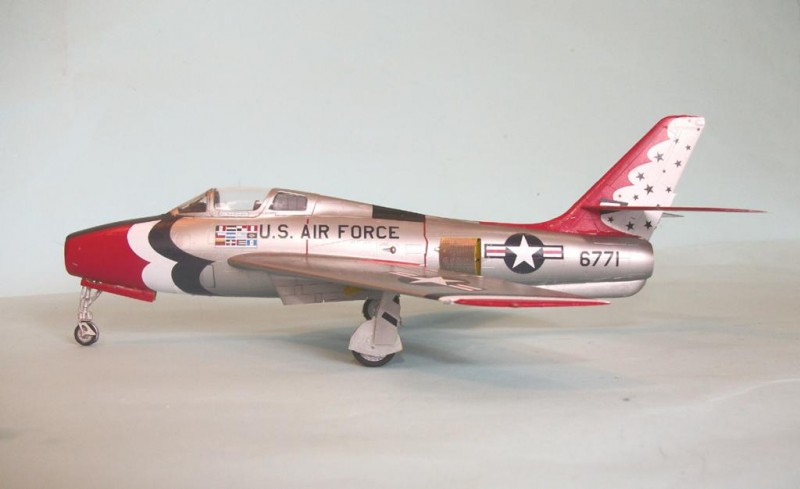
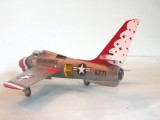
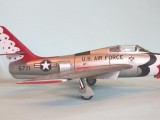

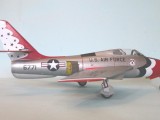
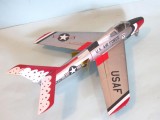
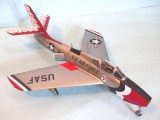
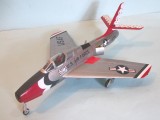
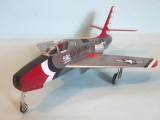
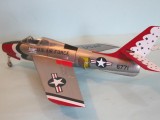
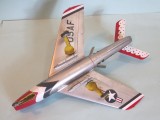
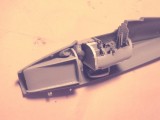

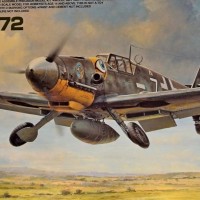
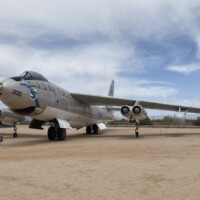
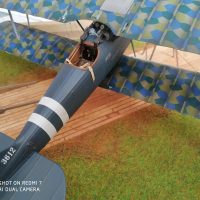
"...Lt. Col. Robert R. Scott..." - of flying tigers fame and author of "God is my Copilot"..?
"...the 'legendary' Jack Broughton..." - he wrote "Thud Ridge", correct? And authored another book IIRC.
How close am I in my assumptions...? Nice finish on the kit, btw.
You're thinking of Robert L. Scott Jr.
Yeah, Broughton was the F-105 commander.
and he wasn't actually in the "flying tigers"...he was in the tigers after the army air force disbanded and shanghaied the unit...it was still led by Chennault and "Tex Hill"...but it wasn't the mercenary band that sported Chinese stars and got paid $500.00 a kill...he was kind of a wannabe cashing in when he painted the teeth on old exterminator...most of the mercenaries were navy pilots that went back...in fact hill was navy but went army after the takeover...Scott never surrendered his commission and kind of cashed in on the fame though he obviously hung out with them a little...the unit eventually expanded to 1000's of people all claiming to be tigers...not...forgive the rant
Nice build, Tom.
I always liked the squat, aggressive look of the '84s. With aftermarket demanding to be displayed these days, it's nice to see a closed canopy for a change, as I think it adds something to the 'line' of the aircraft.
Another beauty, and thanks for the education.
Thanks for a thorough review. I have this kit and intend to build it... your article confirms to me that it should be worth buying a second-hand Monogram kit to cannibalise it for cockpit, u/c parts and wheels - should be a viable alternative to a more expensive resin. The Kinetic kit is still a bit expensive to buy for spares... I just got one second-hand Monogram moulding in Revell boxing for about $15, together with a giant and very competent decal sheet with German, Belgian and Dutch markings.
IIRC Hannants have a wider selection of aftermarket decals, including Aeromaster (ANG), Daco (Belgian), Berna (French), Icarus (Greek) markings
A nice clean build from Tom, as always! The paint application is stunning, it makes this plane look "fast" even sitting on the ground. Very informative narrative as usual from an aircraft guru.
very nice tom...and very complex decals you pulled off there
Well done, Tom. F-84F in T-Birds scheme is very attractive. Really good job on it.
It's certainly a beauty, and a very interesting history lesson from everyone.
Tom, quite a convoluted build with the different kits and aftermarket parts, but as usual, you have made a beautiful job of it, with a seamless and very attractive model, as flown by one of the best, Jacksel Broughton. Thanks for posting!
"The new Hobby Boss kit is an improvement for the fact that it has solved the outline and dimension inaccuracies. However, this does not mean all is well here. The details are still somewhat deficient. The kit manages to copy the main gear well inaccuracy of the ancient Heller kit, resulting in it being too shallow. The intake interior is nearly non-existant. The cockpit has only very basic detail."
That pretty much say's it all. The kit/subject is still evolving and for those discriminating models who care about details... open your wallet , buy,barter or trade for some more up grades. The article is still up beat and positive as always in its attempts to correct and inform the modeler on what to expect in this kit. I wish manufactures would do some more R and D and get it right the first time. Kind of a disappointment given the price.
Tom,
Great build and great info in your article. Always very informative. As a kid I saw the movie "God is My Co Pilot" and immediately became an aircraft enthusiast. Robert L. Scott has been a long time hero of mine. He lived a very long life and I wish that I had had the opportunity to meet him.
Anyone know the name of the actor that played Scott in the movie? Also, who played Chennault?
Robert R. Scott and Robert L. Scott Jr. are two different people Frank. 🙂
I had the pleasure of meeting General Scott at the AFAA convention in 1984, where he said an article I had written about Chuck Yeager that year was "the best article about a fighter pilot I've read." About halfway through his discusssion of why that was true, I realized who "Bob Scott" (as his nametag read) was. Best writing compliment I ever got, and I got to tell him reading his books had been inspirational to my own writing career. After which we bought each other a round.
dennis morgan and raymond massey
That's a jazzy colour scheme, looks great Tom.